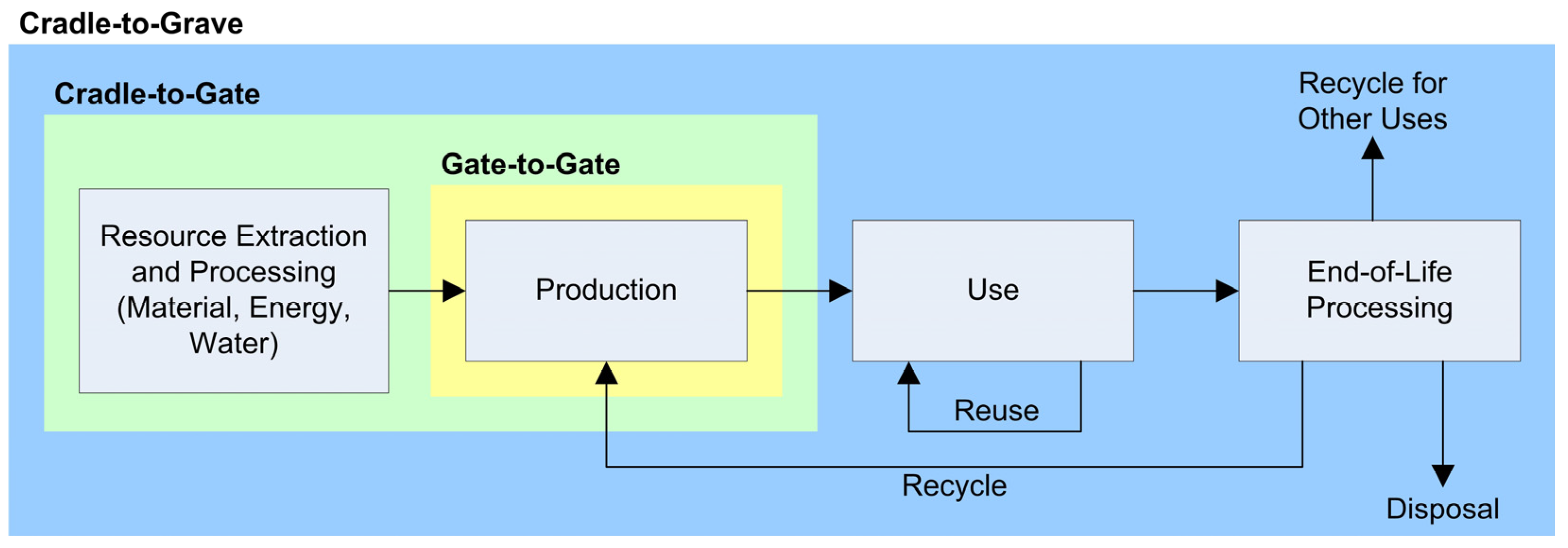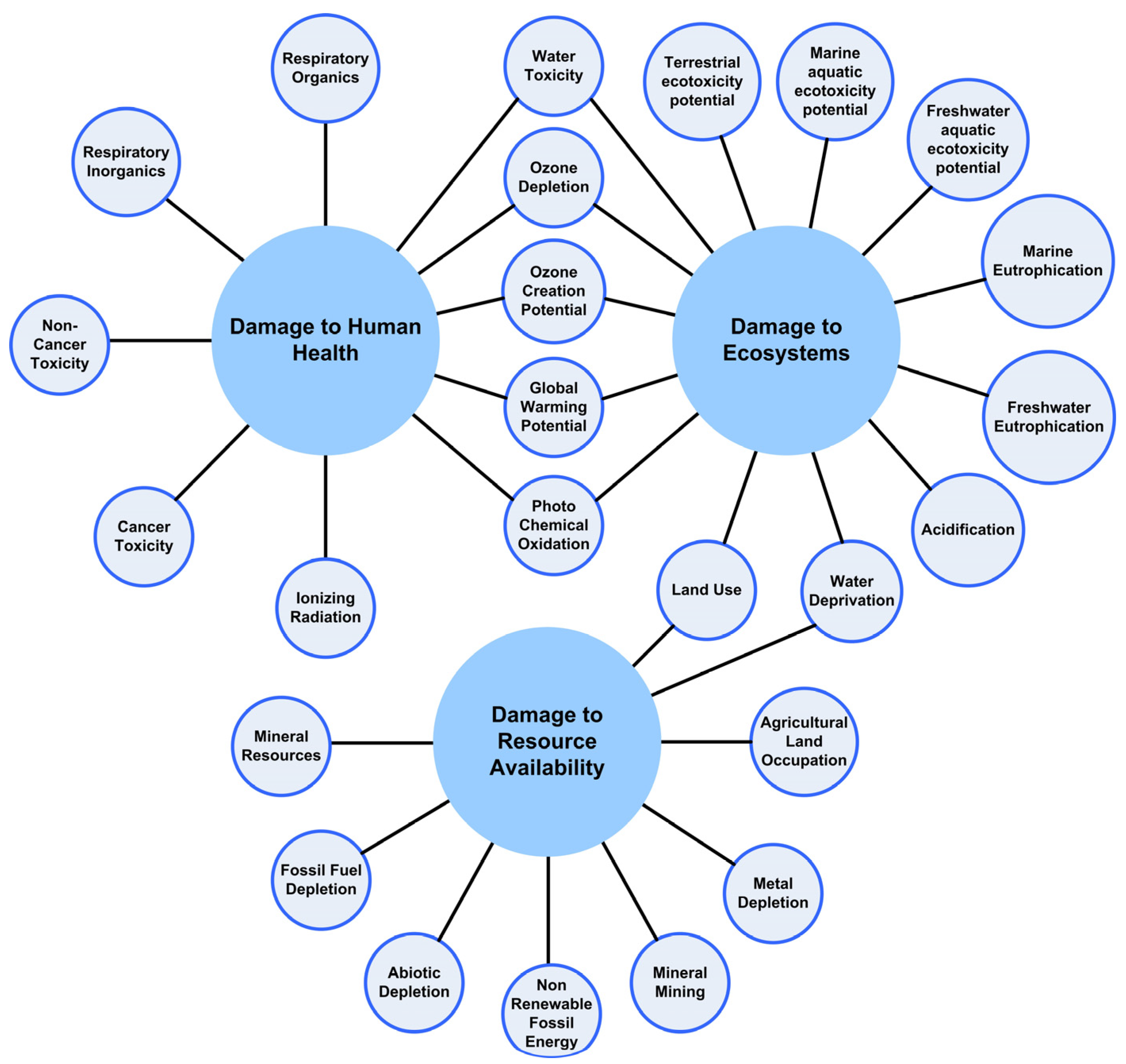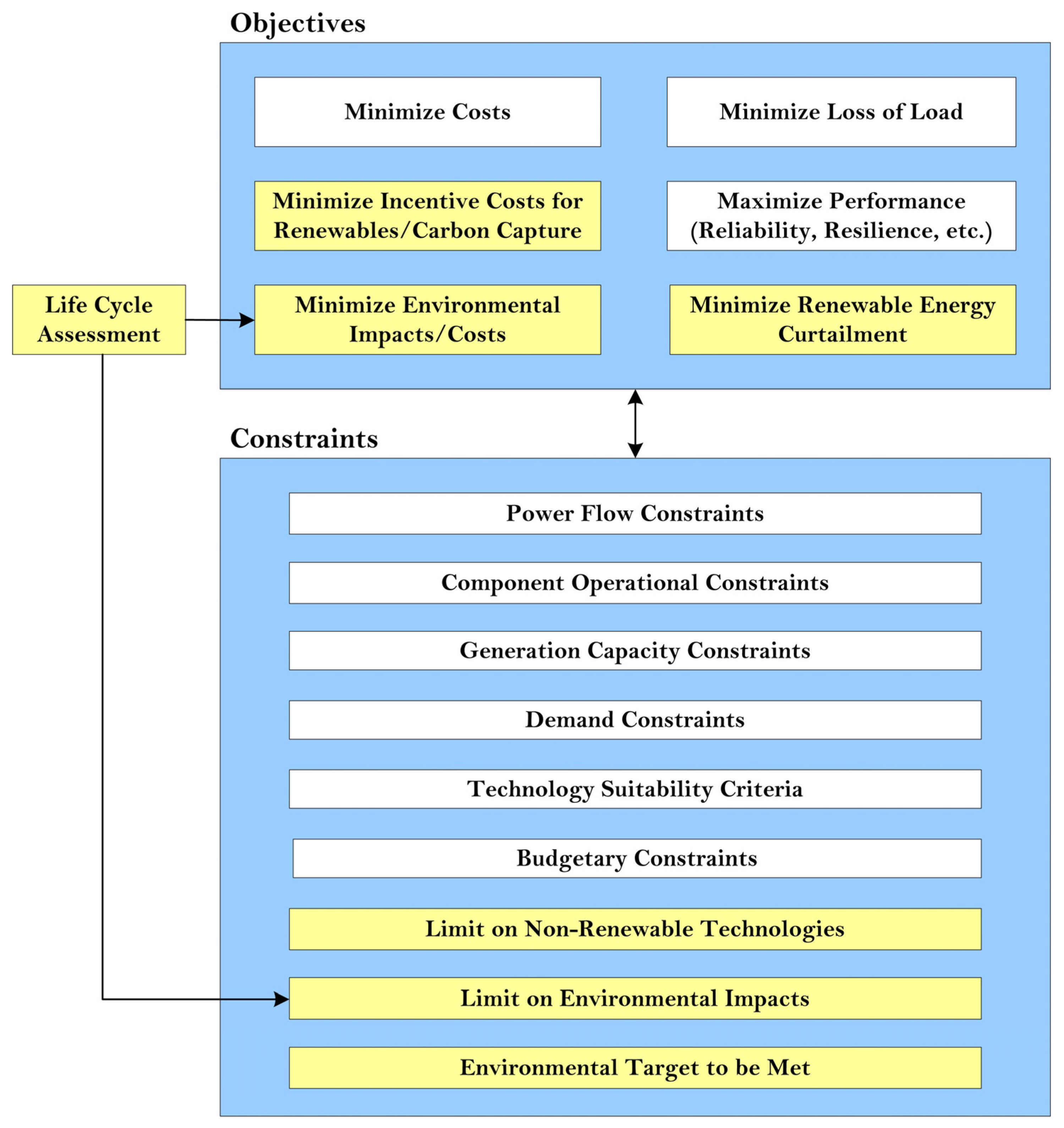Electric demand is steadily increasing, hence requiring continuous investments in modernizing, and expanding power grids worldwide. Traditionally, power system planning projects have considered minimizing the costs of capacity expansion and minimizing the amount of energy not served as the main objectives. With climate change policies enforcing the decommissioning of fossil-fuel-based generation, new clean and renewable generation technologies are being considered for power system capacity expansion projects. However, every generation and transmission technology can potentially have negative impacts on the environment. Life cycle assessment (LCA) is a tool that allows us to evaluate the impacts of these technologies on the environment and society over its entire lifetime.
- capacity expansion planning
- generation planning
- greenhouse gas emissions
- life cycle assessment
- sustainability
1. Introduction
2. Modeling Sustainability through LCA
LCA is a sustainability modeling tool that quantifies the environmental impacts of a product or service over the course of its lifetime. It evaluates the environmental footprint by considering the inputs acquired from nature (e.g., material, energy, water) and the outputs to nature (e.g., waste, emissions to soil/water/air, etc.). LCA is meant to be utilized during the design and development of a product or service to identify environmentally harmful materials, processes, or activities associated with that product or service [23]. After the identification of environmental harms, developers and engineers can consider alternate methods of design to ensure minimal impact on the environment. Alternatively, LCA can be used to compare two or more products in terms of their environmental footprints. Here, it is essential to define a functional unit to be used as the basis of comparison. The international standards organization (ISO) series 14,040 defines and outlines the four phases of life cycle assessment [23], which include goal and scope definition, inventory analysis, impact assessment, and interpretation. To clearly define the goal and scope of the assessment, the product system must be defined, the system boundary developed, and data categories chosen. Some LCA studies are reported as cradle-to-gate, which means that they only include impacts up to the point where the product is pushed out of the gate of the factory and do not consider negative effects that may arise from the product’s use or disposal. Other studies may focus on cradle-to-grave, which offers a comprehensive assessment of the impacts during manufacturing and production (upstream), operation, and disposal (downstream) of the product (see Figure 1). Alternatively, an LCA study may only investigate the impacts associated with one process within the chain of production and use—an approach known as gate-to-gate.

3. Sustainable Power Grids: Capacity Expansion Models
To ensure sustainability in design and capacity expansion, some researchers have used the findings from LCA studies to inform, critique, and compare energy policies and decisions. For instance, authors in [40][25] analyzed the effectiveness of energy transition plans of UK’s largest utility. Authors in [70][26] adopted a similar approach but compared proposed grid mixes in 2030 versus 2010. In [49][27], an LCA-based method was developed to help policymakers with deploying energy storage systems. In another study, authors in [71][28] developed an LCA-based methodology for determining carbon tax incentives that only considered environmental impacts and not cost. Lastly, LCA can help influence policies and regulations within electricity markets by coupling with other models such as optimization, geospatial informatics, net energy analysis, building information, and network theory [44,50,54,58,65,72][29][30][31][32][33][34]. Alternatively, many researchers have proposed sustainability-focused power grid capacity expansion planning with embedded objectives and/or constraints that model environmental impacts. These can be designed to encourage renewable generation technologies or to place limits on non-renewable alternatives (Figure 3). Naturally, one of the easiest ways to expand the power grid in a sustainable fashion is to limit generation options to only renewables and disregard higher-polluting ones. This approach has been adopted by some authors, for instance, in [10,63,73,74][10][35][36][37]. Alternatively, authors in [75][38] proposed to incorporate the external costs of energy generation and transmission (e.g., costs due to environmental and societal damages) into the marginal production costs so that it impacts the supply and demand equilibrium. Authors in [76,77,78,79][39][40][41][42] incorporated a cost term in the objective function to reflect emissions. In [80][43], a carbon tax term was added to the cost objective function.
References
- U.S. Energy Information Administration. International Energy Outlook. 2021. Available online: https://www.eia.gov/outlooks/ieo/pdf/IEO2021_Narrative.pdf (accessed on 29 April 2023).
- International Energy Agency. The Future of Cooling–Opportunities for Energy-Efficient Air Conditioning. May 2018. Available online: https://www.iea.org/reports/the-future-of-cooling (accessed on 29 April 2023).
- International Energy Agency. Global EV Outlook 2020. 2020. Available online: https://www.iea.org/reports/global-ev-outlook-2020 (accessed on 1 May 2023).
- Meza, J.L.C.; Yildirim, M.B.; Masud, A.S.M. A Model for the Multiperiod Multiobjective Power Generation Expansion Problem. IEEE Trans. Power Syst. 2007, 22, 871–878.
- Arabali, A.; Ghofrani, M.; Etezadi-Amoli, M.; Fadali, M.S.; Moeini-Aghtaie, M. A Multi-Objective Transmission Expansion Planning Framework in Deregulated Power Systems With Wind Generation. IEEE Trans. Power Syst. 2014, 29, 3003–3011.
- Sepasian, M.S.; Seifi, H.; Foroud, A.A.; Hatami, A.R. A Multiyear Security Constrained Hybrid Generation-Transmission Expansion Planning Algorithm Including Fuel Supply Costs. IEEE Trans. Power Syst. 2009, 24, 1609–1618.
- Baringo, L.; Baringo, A. A Stochastic Adaptive Robust Optimization Approach for the Generation and Transmission Expansion Planning. IEEE Trans. Power Syst. 2018, 33, 792–802.
- Pozo, D.; Sauma, E.E.; Contreras, J. A Three-Level Static MILP Model for Generation and Transmission Expansion Planning. IEEE Trans. Power Syst. 2012, 28, 202–210.
- Yao, F.; Chau, T.K.; Zhang, X.; Iu, H.H.-C.; Fernando, T. An Integrated Transmission Expansion and Sectionalizing-Based Black Start Allocation of BESS Planning Strategy for Enhanced Power Grid Resilience. IEEE Access 2020, 8, 148968–148979.
- Gu, Y.; McCalley, J.D.; Ni, M. Coordinating Large-Scale Wind Integration and Transmission Planning. IEEE Trans. Sustain. Energy 2012, 3, 652–659.
- Khodaei, A.; Shahidehpour, M.; Wu, L.; Li, Z. Coordination of Short-Term Operation Constraints in Multi-Area Expansion Planning. IEEE Trans. Power Syst. 2012, 27, 2242–2250.
- Aghaei, J.; Amjady, N.; Baharvandi, A.; Akbari, M.-A. Generation and Transmission Expansion Planning: MILP–Based Probabilistic Model. IEEE Trans. Power Syst. 2014, 29, 1592–1601.
- Yin, S.; Wang, J. Generation and Transmission Expansion Planning Towards a 100% Renewable Future. IEEE Trans. Power Syst. 2020, 37, 3274–3285.
- López, J.Á.; Ponnambalam, K.; Quintana, V.H. Generation and Transmission Expansion Under Risk Using Stochastic Programming. IEEE Trans. Power Syst. 2007, 22, 1369–1378.
- Munoz-Delgado, G.; Contreras, J.; Arroyo, J.M.; de la Nieta, A.S.; Gibescu, M. Integrated Transmission and Distribution System Expansion Planning Under Uncertainty. IEEE Trans. Smart Grid 2021, 12, 4113–4125.
- Mavalizadeh, H.; Ahmadi, A.; Gandoman, F.H.; Siano, P.; Shayanfar, H.A. Multiobjective Robust Power System Expansion Planning Considering Generation Units Retirement. IEEE Syst. J. 2017, 12, 2664–2675.
- Moreira, A.; Pozo, D.; Street, A.; Sauma, E. Reliable Renewable Generation and Transmission Expansion Planning: Co-Optimizing System’s Resources for Meeting Renewable Targets. IEEE Trans. Power Syst. 2016, 32, 3246–3257.
- Hong, S.; Cheng, H.; Zeng, P. N-K Constrained Composite Generation and Transmission Expansion Planning With Interval Load. IEEE Access 2017, 5, 2779–2789.
- Li, J.; Li, Z.; Liu, F.; Ye, H.; Zhang, X.; Mei, S.; Chang, N. Robust Coordinated Transmission and Generation Expansion Planning Considering Ramping Requirements and Construction Periods. IEEE Trans. Power Syst. 2017, 33, 268–280.
- Shu, J.; Wu, L.; Zhang, L.; Han, B. Spatial Power Network Expansion Planning Considering Generation Expansion. IEEE Trans. Power Syst. 2014, 30, 1815–1824.
- Romero, N.R.; Nozick, L.K.; Dobson, I.D.; Xu, N.; Jones, D.A. Transmission and Generation Expansion to Mitigate Seismic Risk. IEEE Trans. Power Syst. 2013, 28, 3692–3701.
- The 17 Sustainable Development Goals. United Nations. Available online: https://sdgs.un.org/goals (accessed on 19 March 2023).
- Finkbeiner, M.; Inaba, A.; Tan, R.; Christiansen, K.; Klüppel, H.-J. The New International Standards for Life Cycle Assessment: ISO 14040 and ISO 14044. Int. J. Life Cycle Assess. 2006, 11, 80–85.
- Simonen, K. Life Cycle Assessment; Routledge: New York, NY, USA, 2014.
- Raugei, M.; Kamran, M.; Hutchinson, A. A Prospective Net Energy and Environmental Life-Cycle Assessment of the UK Electricity Grid. Energies 2020, 13, 2207.
- Turconi, R.; Tonini, D.; Nielsen, C.F.; Simonsen, C.G.; Astrup, T. Environmental impacts of future low-carbon electricity systems: Detailed life cycle assessment of a Danish case study. Appl. Energy 2014, 132, 66–73.
- Elzein, H.; Dandres, T.; Levasseur, A.; Samson, R. How can an optimized life cycle assessment method help evaluate the use phase of energy storage systems? J. Clean. Prod. 2019, 209, 1624–1636.
- Louis, J.-N.; Allard, S.; Debusschere, V.; Mima, S.; Tran-Quoc, T.; Hadjsaid, N. Environmental impact indicators for the electricity mix and network development planning towards 2050–A POLES and EUTGRID model. Energy 2018, 163, 618–628.
- Walzberg, J.; Dandres, T.; Merveille, N.; Cheriet, M.; Samson, R. Accounting for fluctuating demand in the life cycle assess-ments of residential electricity consumption and demand-side management strategies. J. Clean. Prod. 2019, 240, 118251.
- Colett, J.S.; Kelly, J.C.; Keoleian, G.A. Using Nested Average Electricity Allocation Protocols to Characterize Electrical Grids in Life Cycle Assessment. J. Ind. Ecol. 2015, 20, 29–41.
- Harrison, G.P.; Maclean, E.J.; Karamanlis, S.; Ochoa, L.F. Life cycle assessment of the transmission network in Great Britain. Energy Policy 2010, 38, 3622–3631.
- Kim, H.; Holme, P. Network Theory Integrated Life Cycle Assessment for an Electric Power System. Sustainability 2015, 7, 10961–10975.
- Munné-Collado, I.; Aprà, F.M.; Olivella-Rosell, P.; Villafáfila-Robles, R. The Potential Role of Flexibility During Peak Hours on Greenhouse Gas Emissions: A Life Cycle Assessment of Five Targeted National Electricity Grid Mixes. Energies 2019, 12, 4443.
- Ding, N.; Pan, J.; Liu, J.; Yang, J. An optimization method for energy structures based on life cycle assessment and its ap-plication to the power grid in China. J. Environ. Manag. 2019, 238, 18–24.
- Tumiran; Sarjiya; Putranto, L.M.; Putra, E.N.; Budi, R.F.S.; Nugraha, C.F. Generation and Transmission Expansion Planning in Remote Areas by considering Renewable Energy Policy and Local Energy Resources: The Case Study of Jayapura Power System. In Proceedings of the 2021 3rd International Conference on High Voltage Engineering and Power Systems (ICHVEPS), Bandung, Indonesia, 5–6 October 2021; pp. 143–148.
- Obushevs, A.; Oleinikova, I. Transmission expansion planning considering wholesale electricity market and integration of renewable generation. In Proceedings of the 11th International Conference on the European Energy Market (EEM14), Krakow, Poland, 28–30 May 2014; pp. 1–6.
- Wang, R.; Zhao, Y.; Xiao, Y.; Xie, H. Coordinated Planning of Renewable Energy and Grid Expansion Based on Scenario Trees. In Proceedings of the 2020 IEEE Sustainable Power and Energy Conference (iSPEC), Chengdu, China, 23–25 November 2020; pp. 485–490.
- Papaemmanouil, A.; Andersson, G. Coordinated expansion planning based on a cost benefit analysis. In Proceedings of the 2009 6th International Conference on the European Energy Market, Leuven, Belgium, 27–29 May 2009; pp. 1–6.
- Bent, R.; Toole, G.L. Grid expansion planning for carbon emissions reduction. In Proceedings of the 2012 IEEE Power and Energy Society General Meeting, San Diego, CA, USA, 22–26 July 2012; pp. 1–8.
- Lei, J.; Xin, H.; Xie, J.; Gan, D. Optimization of distributed energy systems taking into account energy saving and emission reduction. In Proceedings of the 2009 International Conference on Sustainable Power Generation and Supply, Nanjing, China, 6–7 April 2009; pp. 1–6.
- Parizy, E.S.; Choi, S.; Bahrami, H.R. Grid-Specific Co-Optimization of Incentive for Generation Planning in Power Systems With Renewable Energy Sources. IEEE Trans. Sustain. Energy 2019, 11, 947–957.
- Özalay, B.; Müller, C.; Raths, S.; Schettler, A. Analysis of Future Power Generation Structures with a Multi-Period, Multi-Objective Expansion Model. In Proceedings of the 2014 49th International Universities Power Engineering Conference (UPEC), Cluj-Napoca, Romania, 2–5 September 2014.
- Akbarzade, H.; Amraee, T. A Model for Generation Expansion Planning in Power Systems Considering Emission Costs. In Proceedings of the 2018 Smart Grid Conference (SGC), Sanandaj, Iran, 28–29 November 2018; pp. 1–5.
- Saboori, H.; Hemmati, R. Considering Carbon Capture and Storage in Electricity Generation Expansion Planning. IEEE Trans. Sustain. Energy 2016, 7, 1371–1378.
- Das, I.; Bhattacharya, K.; Canizares, C. Optimal Incentive Design for Targeted Penetration of Renewable Energy Sources. IEEE Trans. Sustain. Energy 2014, 5, 1213–1225.
- Nagothu, K.S.; Arroju, M.; Maheswarapu, S. A novel approach to sustainable Power System Expansion planning with inclusion of Renewable Energy. In Proceedings of the 2013 IEEE 7th International Power Engineering and Optimization Conference (PEOCO), Langkawi, Malaysia, 3–4 June 2013; pp. 535–539.
- Muthahhari, A.A.; Putranto, L.M.; Sarjiya; Tumiran; Anugerah, F.S.; Priyanto, A.; Isnandar, S.; Savitri, I. Environmental Considerations in Long-Term Generation Expansion Planning with Emission Limitations: An Analysis of the Sulawesi Power System in Indonesia. In Proceedings of the 2020 FORTEI-International Conference on Electrical Engineering (FORTEI-ICEE), Bandung, Indonesia, 23–24 September 2020; pp. 29–34.
- Junne, T.; Cao, K.-K.; Miskiw, K.K.; Hottenroth, H.; Naegler, T. Considering Life Cycle Greenhouse Gas Emissions in Power System Expansion Planning for Europe and North Africa Using Multi-Objective Optimization. Energies 2021, 14, 1301.
- Rauner, S.; Budzinski, M. Holistic energy system modeling combining multi-objective optimization and life cycle assessment. Environ. Res. Lett. 2017, 12, 124005.
- Yuan, B.; Wu, S.; Zong, J. Multi-area generation expansion planning model of high variable generation penetration. In Proceedings of the 2017 2nd International Conference on Power and Renewable Energy (ICPRE), Chengdu, China, 20–23 September 2017; pp. 645–648.
- Babatunde, O.; Munda, J.; Hamam, Y. Renewable Energy Technologies for Generation Expansion Planning: A fuzzy modified similarity-based approach. In Proceedings of the 2019 IEEE 2nd International Conference on Renewable Energy and Power Engineering (REPE), Toronto, ON, Canada, 2–4 November 2019; pp. 216–220.
- Contreras-Ocana, J.E.; Chen, Y.; Siddiqi, U.; Zhang, B. Non-Wire Alternatives: An Additional Value Stream for Distributed Energy Resources. IEEE Trans. Sustain. Energy 2019, 11, 1287–1299.
- Zhang, Q.; Li, A.; Liu, L.; Cheng, H.; Liu, D.; Zhang, L.; Xu, T. Transmission Expansion Planning Coordinated with Distribution Networks Considering High Renewable Energy Penetration. In Proceedings of the 2020 IEEE Sustainable Power and Energy Conference (iSPEC), Chengdu, China, 23–25 November 2020; pp. 415–422.
